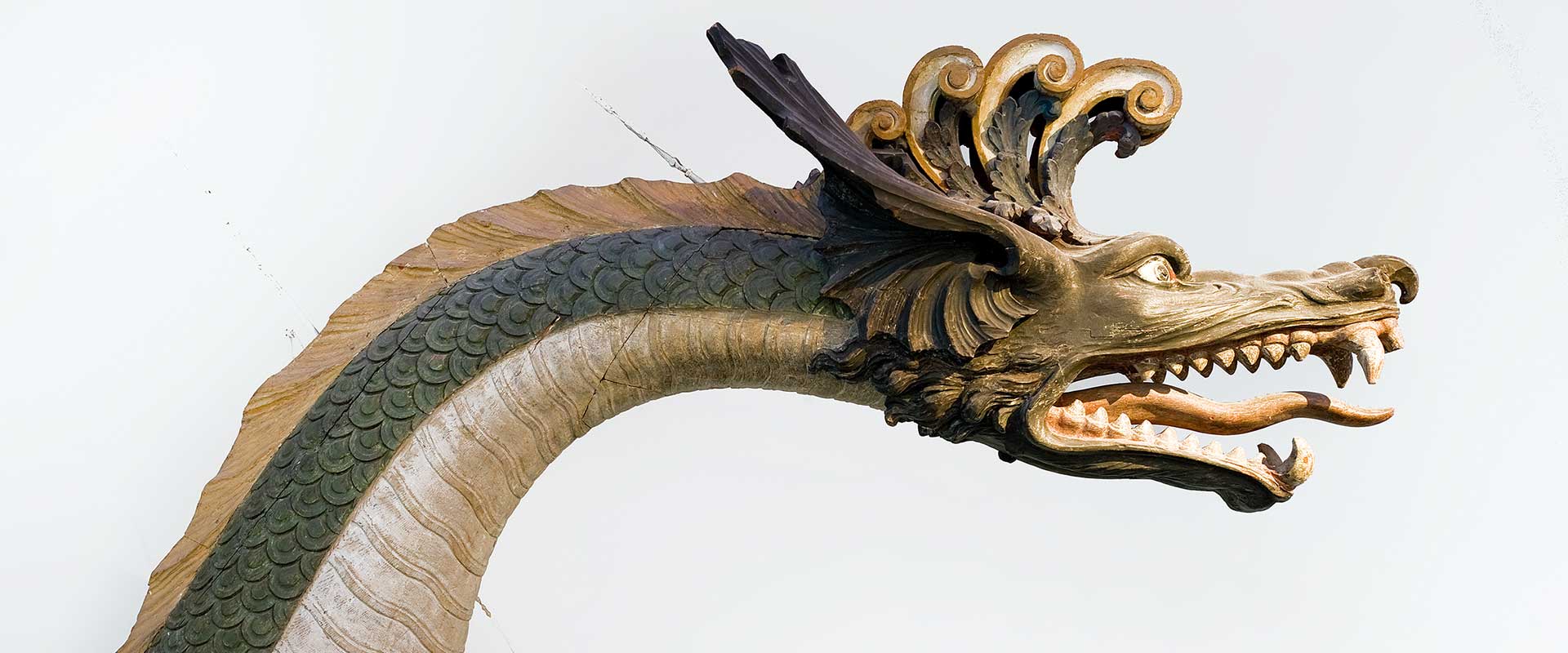An impressive dragon’s head and tail adorn the stairwell at the Maritime Museum. Both beautifully sculpted in wood, they once adorned the five-metre-long 19th-century sloop Draken (Dragon) – a sailing boat that was enigmatic in several ways.
Delivered to the Royal Governor at Drottningholm Palace on 27 July 1801, this pleasure boat was a little more than five metres long, about one-and-a-half metres wide, and was propelled by oars. The bow featured a dragon’s head with a long neck, and the transom a dragon’s tail. Naturally, the boat had been named Draken. It was designed and built by the renowned shipbuilder Fredrik Henrik af Chapman, the man largely responsible for creating Gustav III’s fleet of mighty ships of the line and frigates in the 1780s.
When Draken was delivered to the Governor in the early 19th century, af Chapman was approaching his 80th birthday. Gustav III’s son Gustav IV Adolf, was king of Sweden and the small boat would be used for excursions and festivities for the court at Drottningholm Palace.
Draken was built in the naval dockyard at Karlskrona and the surviving records reveal information about which colours were used when the boat was painted; indigo, gold and Prussian blue are just some examples.
Chinese inspiration
Draken was an enigma. Why was she given a dragon’s head and tail? We do not know, but it is easy to speculate, and China is an obvious source of inspiration. The dragon is the most powerful symbol in Chinese mythology, signifying power, wisdom and harmony. Chinese dragon boats were first used long before the birth of Jesus. These long, narrow vessels are characterized by a dragon’s head at the bow and a dragon’s tail at the transom.
Af Chapman’s original drawing of Draken, which is preserved at the National Maritime Museum, is dated 24 November 1797. In the middle and latter half of the 18th century, Chinoiserie – a style that attempts to imitate Chinese art, fashion and architecture – was very popular in Europe, the Chinese Pavilion at Drottningholm Palace being a perfect example. It was also a time when Europe’s various East India Companies were bringing home typical Chinese goods such as porcelain and silk. China was a country that was both fascinating and admired.
Clues from Skärva
Fredrik Henrik af Chapman’s home also had an obvious Chinese influence. He had a collection of hundreds of paintings depicting a range of Chinese boats at his Skärva mansion in Blekinge. Perhaps his brother Charles, officer and later captain of the Swedish East India Company, brought them back from one of his trips to Asia.
The Dutchman Cornelis van Yk’s “De Nederlandsche Scheepsbouw-konst” is part of af Chapman’s extensive collection of books on shipbuilding. The book features an illustration of a Chinese dragon boat, and in af Chapman’s copy, someone has added a pencil drawing of a sloop above the illustration of the dragon boat – maybe af Chapman himself…
It seems highly likely that af Chapman took inspiration from China when he built Draken.
Draken’s mysterious end
Draken seems to have had a fairly short life, even if the circumstances surrounding her demise are somewhat unclear. In a memo dated 1819 that deals with various deficiencies at Drottningholm Palace, you can read that Draken had “floated off following high water levels in 1818”. But if she floated away and disappeared, how could her dragon’s head and tail have survived?
What we do know is that the dragon’s head and tail ended up in Drottningholm Palace Theatre, where they were used as scenery. In 1987, they were deposited in the Maritime Museum by the Drottningholm Theatre Museum. Now they are all that remain of this enigmatic pleasure boat from the early 19th century.
